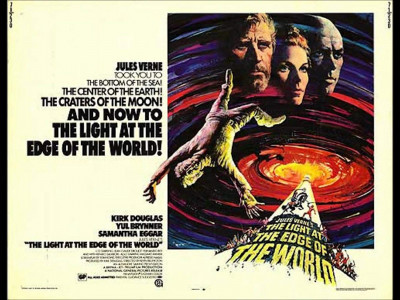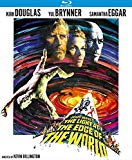| Reviews & Columns |
|
Reviews DVD TV on DVD Blu-ray 4K UHD International DVDs In Theaters Reviews by Studio Video Games Features Collector Series DVDs Easter Egg Database Interviews DVD Talk Radio Feature Articles Columns Anime Talk DVD Savant Horror DVDs The M.O.D. Squad Art House HD Talk Silent DVD
|
DVD Talk Forum |
|
|
| Resources |
|
DVD Price Search Customer Service #'s RCE Info Links |
|
Columns
|
|
|
Light at the Edge of the World, The
Set in 1865, its story takes place on the remote, rocky archipelago of the Tierra del Fuego, the southernmost tip of South America, where expatriate American Will Denton (Kirk Douglas), works as a lighthouse assistant under old sea Captain Moriz (Fernando Rey), and young assistant Felipe (Massimo Ranieri), who keeps a pet monkey, Mario. In flashbacks we see that Denton, a former gold miner, fled his former life under mysterious circumstances.
A ship loaded with sadistic pirates appears. From afar, Denton watches helplessly as Moriz and Felipe are horribly murdered, and Denton, unable to access the locked gun cabinet, can do little but hide out in one of the myriad caves on the island. The pirate captain, Kongre (Yul Brynner), is aware of Denton's presence, taunting him to surrender himself. Denton barely evades capture, but again can do nothing when the merciless wreckers douse the lighthouse light and cause the wreck of a British passenger liner. In another horrifying scene, the pirates stab, strangle, and slit the throats of the survivors who barely make it to shore, including women and children.
Kongre spares only Arabella (Samantha Eggar), an English maid claiming to be her dead mistress, hoping that her presumed aristocracy will help her survive. Kongre sleeps with her, she preferring that to gang-rape by his sub-human crew, though he plans to eventually sell her into slavery. Meanwhile, Denton manages to save one final survivor, ship's engineer Montefiori (Renato Salvatori).
The Light at the Edge of the World was first distributed in the U.S. by National General with a "GP" rating, the equivalent of today's PG, but that release may have been heavily trimmed of all the graphic violence. This complete version runs 128 minutes, longer even than the Internet Movie Database's listing of 120 minutes. By the end of the picture there are more dead bodies and fewer survivors on that cursed island than Hamlet: women and infants drown in the sinking passenger ship offshore, one character is graphically flayed, and, though faked, there's a disturbing moment of terrible animal cruelty.
In short, these pirates mean business. They are among the most historically accurate in film, and whoever did the casting made certain each and every one of them is a believable threat to Will's life. Brynner is especially good, eschewing his usual flamboyance, he allows his costumes and the set decoration to do that for him. Having taking over the utilitarian lighthouse, he transforms it into a kind of palace, which he lords over with understated cruelty. In one series of shots near the end, the camera shoots up at Brynner from a low angle. He's just sitting there, unmoving as Denton draws near. Yet Brynner's screen presence is genuinely overpowering, really commanding the screen. Indeed, watching him here it occurred to me how the producers of the James Bond films really blew it by not casting him as arch-villain Ernst Stavro Blofeld in the 007 movies of the period. He'd have been the perfect distillation of both the character from the novels and the films.
Kirk Douglas was a mere (it seems now) 54 years old at the time, yet still incredibly fit, that and his hardened features making it plausible that through a combination of physical agility and knowledge of the island he could elude the pirates for as long as he does. Like Brynner he underplays almost every scene, allowing the audience to read his thoughts and this works marvelously.
Unfortunately, The Light at the Edge of the World has a few major problems. Though Douglas's Bryna Productions was one of the producers, and Kirk himself is credited as producer (and probably supervised British TV director Kevin Billington, much as he did with Stanley Kubrick on Spartacus and other directors on other films), he seems to have left too much of the rest of the work to other, less talented hands.
For starters, the miniatures of the various ships encountering the island are poor, looking like bathtub toys. The opening and closing titles have the cheesiness of a cheap spaghetti Western, and the musical score by Piero Piccioni, is frequently awful. Much of the film was shot day-for-night, but either the timing is off on the remastering or perhaps always looked that way. Either way, the over brightness of all these scenes often makes the staging look ridiculous, with Will in plain sight mere feet away from the pirates who wouldn't see Denton under cover of darkness but in this light is unavoidable.
With all the violent mayhem, dummies are used occasionally to show characters thrown off cliffs, etc., yet this is so patently phony in its execution that it becomes laughable, and a key scene is almost ruined because of this.
On the plus side, the Panavision lensing of the locations, in Spain, is quite impressive. The surf-swept rocky coast is as treacherous looking as that in David Lean's Ryan's Daughter.
Video & Audio
Licensed from Studio Canal, the complete, Kino's 2.35:1 widescreen Blu-ray of The Light at the Edge of the World has fairly weak title elements, though the rest of the feature generally looks impressive, especially on big projection screens, the landscapes and surging seas really coming off well. And, as noted above, this is the complete 128-minute version. The audio, DTS-HD Master Audio mono, is also good. Region "A" encoded.
Extra Features
Supplements include a good audio commentary track by Howard S. Berger and Nathaniel Thompson, incorporating interviews with associate producer Ilya Salkind and director Billington. A trailer and radio spot are also included.
Parting Thoughts
A very hard-edged adventure film, dark and even cruel yet rewarding if compromised by sloppy production elements, The Light at the Edge of the World is Highly Recommended.
Stuart Galbraith IV is the Kyoto-based film historian currently restoring a 200-year-old Japanese farmhouse.
|
| Popular Reviews |
| Sponsored Links |
|
|
| Sponsored Links |
|
|
| Release List | Reviews | Shop | Newsletter | Forum | DVD Giveaways | Blu-Ray | Advertise |
|
Copyright 2024 DVDTalk.com All Rights Reserved. Legal Info, Privacy Policy, Terms of Use,
Manage Preferences,
Your Privacy Choices | |||||||














